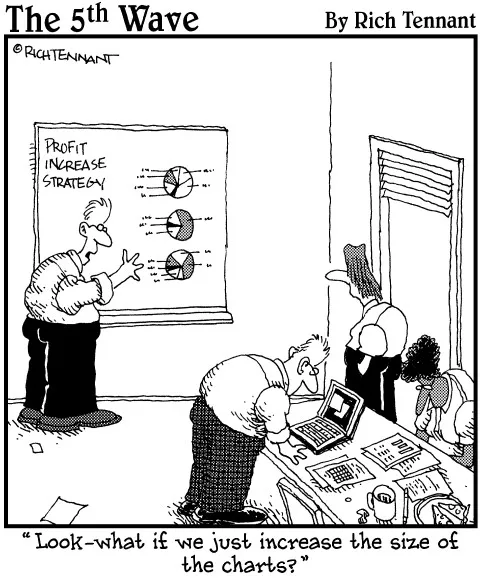In this part . . .
So how can you put all that information to work for you? Some of the data’s on your laptop, some of it’s on your desktop at home, and a little bit of it is on your handheld. It would be nice to be able to look into the past and find meaningful insights about what’s made your lemonade stand successful in the past, and what might make it more successful in the future. That might help make decisions easier.
You need a business intelligence solution. The chapters in this part will show you what BI is, how it’s related to other technology areas, and how it can work for lemonade stands just like yours.
Chapter 1
Understanding Business Intelligence
In This Chapter
Getting comfortable with the basics
Understanding the business intelligence value proposition
Seeing where BI came from and where it’s going
Previewing what works (and what doesn’t)
From the CEO down to the lowest levels of any organization, every minute of the day someone is making a decision that has an impact on the company’s performance. Sometimes a decision is at a very high strategic level that affects the fate of the entire organization, and other times a decision might be narrowly defined and tactical, affecting a single person or department for a very short window of time. When taken together, these decisions make up a significant portion of the “day in the life” at any given organization, be it a company, governmental agency, or nonprofit organization.
In spite of the dramatic advances in technology and tools that aid in the decision-making process, however, far too many people still make decisions the old-fashioned way: by blending a gumbo of tidbits of current information, best recollections of the past, advice from others, and a whole lot of “gut instinct,” and then assessing which path is likely to give the best possible outcome for the decision at hand.
Decisions drive organizations. Making a good decision at a critical moment may lead to a more efficient operation, a more profitable enterprise, or perhaps a more satisfied customer. So it only makes sense that the companies that make better decisions are more successful in the long run.
That’s where business intelligence comes in.
Business intelligence is defined in various ways (our chosen definition is in the next section). For the moment, though, think of BI as using data about yesterday and today to make better decisions about tomorrow. Whether it’s selecting the right criteria to judge success, locating and transforming the appropriate data to draw conclusions, or arranging information in a manner that best shines a light on the way forward, business intelligence makes companies smarter. It allows managers to see things more clearly, and permits them a glimpse of how things will likely be in the future.
The Name Game
Business intelligence is commonly known simply as BI. That’s pronounced “Bee Eye,” not “Buy.” We’ll go back and forth in this book between the full phrase and the abbreviated name. And if you’re wondering why there aren’t any periods in the acronym (as in, “B.I.”) it’s because of a custom in the technology world: Once a concept has gained widespread acceptance and becomes known by its initials alone, the punctuation disappears.
Extracting periods from techno-acronyms (CPU, GB, ICBM, whatever) is the mission of the International Punctuation Review Board, a group of Internet billionaires, former ambassadors, and high school football coaches who meet in Geneva every four years to review which new buzzwords qualify for punctuation-free status. (Just kidding. Everything about acronyms in the previous paragraph is true but the Board doesn’t really exist. Yet.)
Limited Resources, Limitless Decisions
All organizations, whether business, government, charitable, or otherwise, have limited resources for performing their missions. Companies are forced to make do with what they have — all the time. You can’t put a Nobel laureate in every position, and you can’t pour unlimited dollars into an endless quest to make all your factories and offices more efficient.
The most precious resource is time. The marketplace is in constant motion, and companies must not only move correctly, they must move quickly. Otherwise competitors will fill any available vacuum in the market, resources will get used up, and your organization will inexorably wither away.
Business intelligence’s entire raison d’être (that’s French for “shade of lipstick” — just kidding) is as an ally at those inflection points throughout the life of a business where a decision is required. Business intelligence is a flexible resource that can work at various organizational levels and various times — these, for example:
A sales manager is deliberating over which prospects the account executives should focus on in the final-quarter profitability push
An automotive firm’s research-and-development team is deciding which features to include in next year’s sedan
The fraud department is deciding on changes to customer loyalty programs that will root out fraud without sacrificing customer satisfaction
The decisions can be strategic or tactical, grand or humble. But they represent two roads diverging in a yellow wood: Considered in the aggregate, the roads taken and those not taken represent the separation between successful and unsuccessful companies. Better decisions, with the help of business intelligence, can make all the difference.
Business Intelligence Defined: No CIA Experience Required
So what the heck is business intelligence, anyway? In essence, BI is any activity, tool, or process used to obtain the best information to support the process of making decisions.
Right now you’re scratching your head and wondering, “Does he really mean anything?” And the answer is a qualified yes. Whether you’re calling the Psychic Hotline, using an army of consultants, or have banks of computers churning your data; if it helps you get a better handle on your company’s current situation, and provides insight into what to do in the future, it’s BI.
But by popular demand (and so I don’t have to write a chapter called “Using a Magic 8-Ball for Improved Portfolio Risk Management”) we’ll narrow the definition just a tad. For our purposes, BI revolves around putting computing power (highly specialized software in concert with other more common technology assets) to work, to help make the best choices for your organization. Okay, there’s a little more to it than that. But before digging into specifics, it is (as the Magic 8-ball would say) decidedly so that you should understand some context about how BI is defined, and who’s defining it.
The more you learn about BI, the more likely you are to encounter a wide swath of definitions for the term. Sometimes it seems as if nearly every new article on BI characterizes it in a new way. BI invariably gets unceremoniously tagged with an array of newfangled labels and connected with a whole catalog of different technologies that can leave your head spinning as you try to peg which elements are included in the definition and which ones aren’t.
And it’s no mystery why there is no single definition for business intelligence. Vendors and consultants define the phrase in a way that conveniently skews toward their particular specialty. Academics, authors, and consultants also have their own pet definitions of BI; one may barely resemble the next.
Don’t get knocked off course. Regardless of who’s saying it, when you put BI on a stove, turn the heat up, and boil it down to its constituent elements, you’ll always find the same thing left in the pot: technology and tools to support decision-making.
For the purposes of this book, and for your needs beyond this book, you’ll only need to know this one single definition (drum roll, please...










